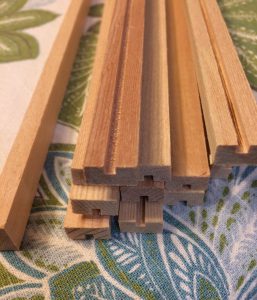This morning I went out to check the epoxy on the bending form. It’s not warm in the garage (low 50s), not ideal for curing epoxy. In addition, I was not too precise in mixing the epoxy. I have a small scale that weighs in grams, ounces or even carats that I plan to use for epoxy to be used when measuring epoxy for actual airplane parts, but I didn’t use that last night. Anyway, the glue was hard but still a little tacky on the surface – so not totally cured but “OK enough” to use. I pulled the three capstrips out of the water soak and clamped them in the form. A few hours later they had taken a fairly good set — but one of them cracked at the peak of the bend. Looking at that one, it would have been OK if I’d either bent the other end, or cut the slot on the opposite side. I just happened to try to bend it in a direction that didn’t work well with the grain slope of that piece of wood. I’ll have to watch that on future pieces.
Knowing that I’ll want to rip some 1/8″ thick strips to make the wingtip bows and the frames for the tail feathers, I went looking for a way to do that easily. I’ve been successful in ripping thin strips on the table saw, but as countless others have discovered doing it between the blade and rip fence is not the safest way. The blade tends to launch the cut strip backwards off the saw table. I found this thin strip rip jig at Rockler.com, which looks to be exactly the tool I need to rip pieces for laminating. It’s not expensive, and I can think of a dozen other projects for which it would be very useful to be able to make strips for curved laminations. I ordered it.
At lunch time I pulled the strips out of the bending jig and installed the rest of the forming blocks on the rib jig. As I thought, the bottom capstrips won’t need to be pre-bent. So, the first rib jig is ready to go.
The next job will be to shave the 1/8″ x 3/8″ strips received from ACS down to 3/32″ thick. They’re actually a little thicker than spec, around .135 or so. I thought about setting up something to jig up my low end belt/disc sander to do the job, but I don’t see a lot of success there. I have a razor plane, but it doesn’t seem to work well on the wide side of the spruce strips. I will have to figure out a good way to shave or sand or plane these down to the right thickness. I did cut out all of the geodetic braces for the first rib, and marked them according to their placement. I’ll use them as patterns to cut the remainder — just as soon as I figure out how to get those strips pared down to the right thickness. Sanding just the ends down is going to be too time consuming and the results would probably not be consistent enough to suit me. I need to figure out the best way to shave about .040 to .045 off of those strips.


 waiting…
waiting… on…
on…  the wood…
the wood… 